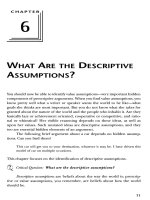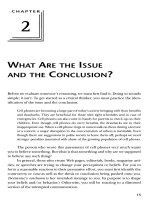What are conjunctions
Bạn đang xem bản rút gọn của tài liệu. Xem và tải ngay bản đầy đủ của tài liệu tại đây (9.33 KB, 1 trang )
What are conjunctions?
Conjunctions are words like
and, but, or, yet, because, since and so
.
Read the following sentences:
1. God made the country
and
man made the town.
2. She must cry,
or
she will die.
3. Two
and
two make four.
In sentence 1 and 2, the conjunctions
and
and
or
join two sentences together. In sentence 3, the conjunction
and
merely joins two words together.
Thus we have seen that a
conjunction
is a word which merely joins two sentences together. Sometimes a
conjunction joins two words together.
Why use conjunctions?
Conjunctions join together sentences and make them more compact. The sentence, ‘John and Peter are good
students’ is a short way of saying ‘John is a good student and Peter is a good student’. Similarly, the sentence
‘He is poor, but honest’ is a contracted way of saying ‘He is poor but he is honest’.
However, sometimes the conjunction
and
joins words only.
Jack
and
Jill went up the hill.
John
and
Peter are good friends.
Note that sentences of this kind cannot be resolved into two.
Conjunctions must be carefully distinguished from relative pronouns, relative adverbs and prepositions which are
also connecting words.
Compare:
This is the house
that
Jack built. (Here the relative pronoun that joins the two clauses ‘this is the house’ and
‘jack built’ together.)
This is the place
where
he was buried. (Here the relative adverb where joins the two clauses ‘this is the place’
and ‘he was buried’ together.)
I was annoyed,
still
I kept quiet. (Here the conjunction still joins the two clauses ‘I was annoyed’ and ‘I kept
quiet’ together.)
Be first to know when grammar rules change! Sign up to our newsletter here: englishgrammar.org (It's free)
Powered by TCPDF (www.tcpdf.org)









